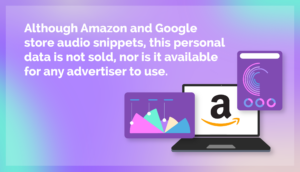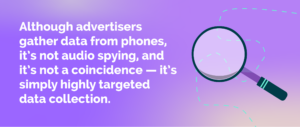We’ve all been there — you have a casual conversation with a friend about, say, tennis, and even though you’ve never expressed interest in tennis in your life, a few hours later, your phone is showing you ads for tennis rackets. So you jump to the most logical conclusion — your phone must be listening to you. It’s no wonder there are so many Google searches like, “How do I stop Google from listening to me,” “Can targeted advertising make my phone hear me?” and “Does iPhone listen to you for ads?”
But is your phone really listening to you?
It might seem like it is — after all, you probably give your apps permission to access your microphone. But the reality is that’s not quite how ad targeting works.
This article will reveal the truth about whether your phone is listening to you and how targeting for digital advertising really works.
Does Targeted Advertising Make Your Phone Listen to Your Conversations?
Although there are nuggets of proof that Amazon and Google store audio snippets, this personal data is not sold, nor is it available for any advertiser to use.
Back in 2017, the New York Times reported that more than 250 mobile gaming apps were partnering with Alphonso, a data-collection company that aggregates CTV viewership information through ACR technology. These Alphonso-partnered apps ask permission for microphone access after they are first downloaded. By doing so, the apps tap into your phone microphone to listen for audio cues from a specific CTV commercial in order to send you mobile ads for the product that was just displayed on your CTV.
While this certainly presents a grey area about phones listening in on your private life, the microphone functionality is triggered by an audio cue from your CTV as opposed to passively listening and collecting data.
Similar to how smart speakers are programmed to wake up when they hear a particular phrase, or how your iPhone knows to answer back when you say, “Hey Siri”, these mobile apps only trigger microphone activation when the exact snippet of audio from the CTV ad is detected. The data is not categorized into segments or packaged for resale.
How to Stop Unwanted Tracking on Your Phone
To protect yourself from any unwanted tracking by these apps, try the following steps:
- Remove all the apps you don’t use from your phone
- Review your app permissions and revoke all permissions that allow them to access:
- Microphone
- Location
- Contacts
- Camera
- Phone SMS
- When you download a new app that asks you for unnecessary permissions, select “Don’t Allow.”
- Limit Access to Microphone
- Google Android
- 1. Open the Google Settings on your device
- 2. Select Apps
- 3. Select the app from the list
- 4. Select Permissions
- 5. Turn off access to the microphone for the app
- Apple iOS
- 1. Open the Settings on your device
- 2. Select Privacy
- 3. Select Microphone
- 4. Turn off access to microphone for the app
- Google Android
In some rare cases, snooping and phone hacking may occur — this caused a massive public scandal in the UK in 2011, when journalists at the now-defunct News of the World — owned by News International (now News UK) — hacked the phones of politicians, royal family members, and crime victims, among others.
However, phone hacking is rare and wouldn’t be a technique that reputable advertisers employ. It is certainly not what targeted advertising is about.
So you might be wondering, “Why did I get an ad for cat food after my friend and I talked about their cats while having lunch together? I don’t even like cats!”
Let’s use the cat food scenario to dive into the possible reasons why you may be on the receiving end of targeted advertising—and how targeted advertising really works.

1. Your Friend Has Cats
In this case, what is likely happening is a simple case of linked profiles. If you and your friend were connected to the same WiFi network, they might have used contextual targeting based on the IP address to show you ad campaigns about things your friend is interested in or has previously viewed or received emails about.
2. You Were in the Same Location
When you grant access to your location through an app like Google Maps, a social media platform, or even a game, that information is added to your advertising profile.
That location data is then used to serve you targeted ads. But that’s not all — it also syncs with internet users around you, such as a partner, family member, or friend. This means they might see ads that target you — and vice versa.
If a company can determine that you and your friend were in the same location and if your friend had previously had any online interaction with cat-related content or sites, then there’s your connection. They’re using the same behavioral targeting on both of you based on your friend’s user behavior.
That’s why after a conversation about cats, you may notice that you start to get ads relevant to cat owners. However, that doesn’t mean your phone is eavesdropping on you and showing you ads about cat food.
It’s actually the algorithm comparing your advertising profile with those around you and showing you whatever they have interacted with or searched for online.
3. Maybe You’re a Pet Owner
Let’s say you own a dog and always buy dog food. You could be lumped into a third-party dataset for “pet owner,” and the advertiser running the online advertising campaign may not have done the diligence to separate the user data and target cat owners only.
4. Your Demographics Match
Perhaps you and your friend are of a similar age and are both pet owners. If so, advertisers may assume that you’re interested in similar things based on your demographic information.
Add in the fact that you were in the same location when you had the cat conversation, and all these data clues could have been collected to solidify the interest connection.
5. It Could Be Geo-Targeting
Maybe you walked by a pet store on the way to lunch, and they happen to be running a geo-targeted promo for cat food to reach a specific audience and find potential customers in the local area.
You may think that your phone was listening in on your conversation because of this coincidence, but it’s simply a matter of being in a geographical location that is being targeted for a cat food marketing campaign.
6. Did You Search for Cat-Related Information?
Maybe after talking to your friend about their cats, you absent-mindedly opened up a search engine and looked up some cat facts. This kind of online behavior signals to the online ad machine that you probably have some interest in cats — who better to hit with an ad for cat food?
Any of your browsing habits could have led to that ad being served — even if it’s only vaguely related to the information you searched for.
Or maybe you’d been getting the ads all along and only really noticed them after the discussion.
7. It Could Be Mobile Retargeting
For example, if you see a digital-out-of-home (DOOH) cat food ad at a gas station, the advertiser may swoop up your device ID for mobile retargeting with relevant ads.

Busting the Audio Spying Myth
If you don’t understand how targeting advertising works, it can seem like your phone is listening to you — which can feel like an invasion of privacy.
But the truth is that although advertisers gather data about their target audience from their phones, it’s not through audio spying, and it’s not a coincidence — it’s simply highly targeted advertising and data collection.
So now you know that your phone isn’t listening to you, what other advertising myths would you like us to bust?
The Grapeseed Media team holds regular office hours where we provide free expert advice on all things programmatic and digital advertising. Just let us know what you would like to learn about, and we’ll prepare a session for you.




